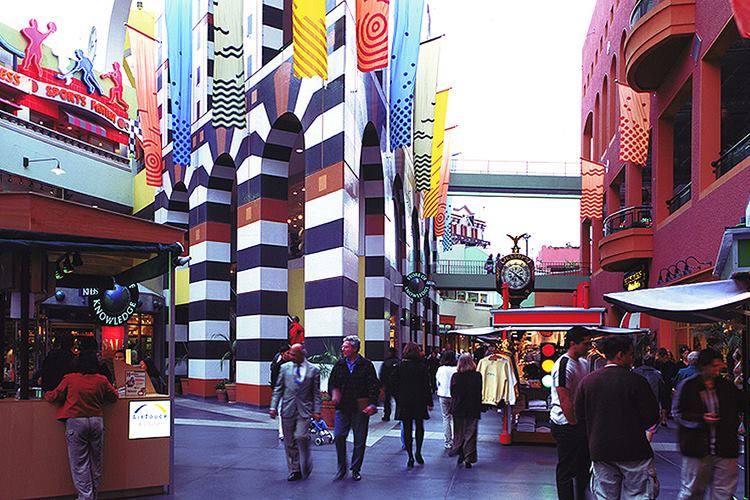Jon Jerde, who passed away on Feb. 9, injected an aura of festival into marketplaces, curved the mall away from the grid and grind of shopping, and brought L.A.’s sprawl together to celebrate the 1984 Olympics. He infused the everyday with color and wit, and along the way made Postmodernism part of our everyday lives.
Years ago, when I was living in Los Angeles, the architect Robert A.M. Stern, FAIA, asked me to chauffeur him to San Diego. The ostensible reason was to visit a small office building his firm had just completed in La Jolla, but it turned out what he really wanted to see was the recently finished Horton Plaza shopping mall Jerde Partnership had designed in 1977 in San Diego’s downtown. Stern, who was and is a voracious reader and looker, wanted to see what he could learn from the man who was already known then as the Master of the Festival Marketplace.
Both Stern and I were impressed. Around a curved walkway that became Jerde’s trademark, the mall unfurled in a riot of colors, forms, and connections. In the decades leading up to the mall’s design, architects such as Charles Moore (who was a founding partner of Santa Monica, Calif.-based Moore Ruble Yudell Architects & Planners) and Robert Venturi, FAIA, had brought some of the basics of both southern European vernacular forms and the classical canon back to architecture: The colonnade, the arched entry, the tripartite façade, and the aedicule (or “ridicula,” as Moore sometimes called it), which put the “primitive hut” back into the heart of the design community. Jerde blew those pieces up, both in scale and into fragments, colored them with abandon, abstracted them for the sake of both cost and modernity, and turned them into markers that transformed retail environments that were made of the same chain stores into distinctive and complex places.
His shopping malls—and those were his bread and butter—still suffered from being inwardly turned, despite his best efforts to give them grand entry pavilions, and became a bit repetitive, sporting that same curve whether they were in Fukuoka or Rotterdam. But, the best of them were always fun and full of light and form, and layered a sense of civic importance and plenty of places to hang out onto the shopping grind.
The Olympics, which he designed together with Deborah Sussman, a graphic designer who passed away last year, took some of those same playful versions of classical elements, colored in pastels and made out of elements as basic as Sonotubes, and scattered them around Southern California. In real life, they became instant monuments and defined pathways in parking lots and along boulevards. On television, which is how millions saw them, they made the hundred-mile radius in which the Games took place appear to be connected and coherent.
Jerde’s Horton Plaza left a lasting impression (remarkably, the mall still exists today largely the way it was designed), and from then on I followed Jerde’s career with interest. He became typecast as the wizard of that festival marketplace, and he may have relied on the curve a bit too often, but you could be sure that every building or complex he designed would be full of pizzazz and piazzas. Jon Jerde sold me on the idea that architecture, however big and however much part of our consumer culture, could be functional and fun.
Aaron Betsky is a regularly featured columnist whose stories appear on this website each week. His views and conclusions are not necessarily those of ARCHITECT magazine nor of the American Institute of Architects.
